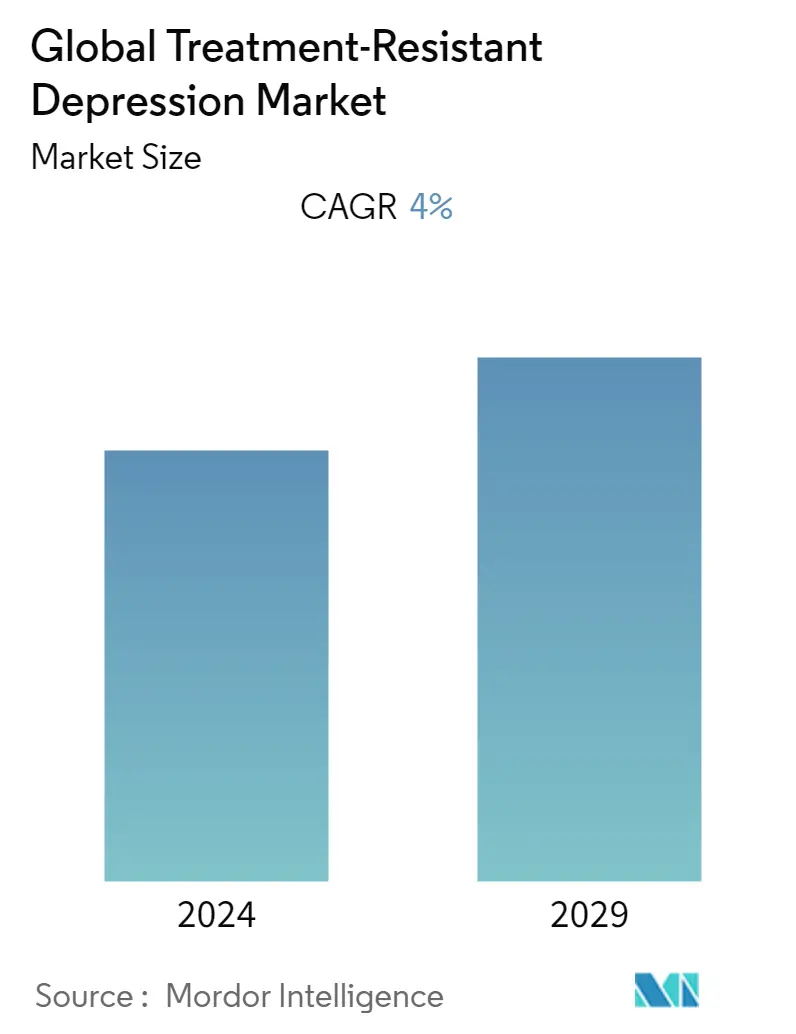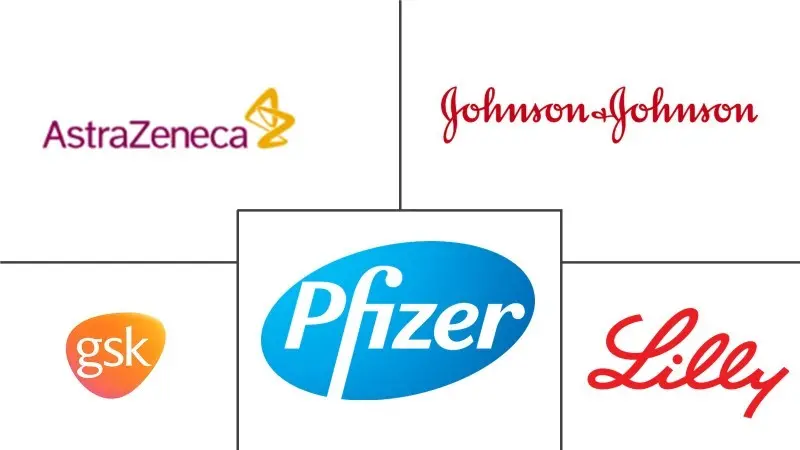Market Size of Global Treatment-Resistant Depression Industry

| Study Period | 2019 - 2029 |
| Base Year For Estimation | 2023 |
| Forecast Data Period | 2024 - 2029 |
| CAGR | 4.00 % |
| Fastest Growing Market | Asia-Pacific |
| Largest Market | North America |
Major Players
*Disclaimer: Major Players sorted in no particular order |
Treatment-Resistant Depression Market Analysis
The Treatment- Resistant Depression market is projected to register a CAGR of 4% during the forecast period.
During COVID-19, the mental state of the individuals was greatly affected, and consequently, most of the persons were suffering from different psychiatric and neuropsychiatric disorders. As per the study published in October 2020, titled 'The Impact of the COVID-19 Pandemic on the Health and Coping Behaviors of Patients With Treatment-Resistant Depression' the COVID-19 pandemic has affected the health of patients with TRD in both positive and negative ways. As the goal of government preventive strategies is to protect and promote public health, regular attention should be paid to the negative effects of long-term exposure to pandemic-related news on this vulnerable population. Therefore, COVID-19 has provided the opportunity for market players for innovative and effective treatment procedures to address the global burden of such increasing anxiety disorders, thereby it is expected to impact the market positively.
The market is majorly driven by rising cases of depression, increasing awareness about depression, and the emergence of novel drugs. According to the World Health Organization (WHO), data updated in June 2021, more than 700,000 people suicide every year, and it is the fourth leading cause of death among 15-19-year-olds. Similarly, In countries such as the United Kingdom in the United States, which are characterized by their fast-paced economies, the percentage of the affected population of every age is quite high. According to the Anxiety and Depression Foundation facts and statistics updated in June 2022, generalized anxiety disorder will affect 6.8 million adults or 3.1% of the United States population per year. Thus, the rising cases of depression across the world are expected to drive the overall growth of the market studied over the forecast period.
Moreover, the manufacturer's interest in developing new medication the United States Food and Drug Administration (USFDA) approval is triggering the growth of the market. For instance, in July 2022, Abbott received the United States Food and Drug Administration's approval to use its deep brain stimulators (DBS) device for treatment-resistant depression (TRD). Moreover, in March 2019, the FDA approved Spravato-non-competitive N-methyl D-aspartate (NMDA) receptor antagonist, in conjunction with an oral antidepressant, for the TRD treatment in adults. It is the first-ever approved NMDA therapy for TRD.
However, severe high costs and a rise in adverse drug reactions significantly hinder the market's growth.
Treatment-Resistant Depression Industry Segmentation
As per the scope of the report, depression that does not respond or show any signs of improvement when treated with an antidepressant is known as treatment-resistance depression. The Treatment- Resistant Depression market is segmented by Drug Class (Selective Serotonin Reuptake Inhibitors, Monoamine Oxidase Inhibitors, Tricyclic Antidepressant Inhibitors, and Others), By Distribution Channel (Hospital Pharmacies, Retail Pharmacies, and Online Pharmacies), and Geography (North America, Europe, Asia-Pacific, Middle East, and Africa, and South America). The Market report also covers the estimated market sizes and trends of 17 countries across major regions globally. The report offers values ( in USD million) for the above segments.
| By Drug Class | |
| Selective Serotonin reuptake inhibitors | |
| Monoamine Oxidase Inhibitors | |
| Tricyclic Antidepressant Inhibitors | |
| Others |
| By Distribution Channel | |
| Hospital Pharmacies | |
| Retail Pharmacies | |
| Online Pharmacies |
| Geography | ||||||||
| ||||||||
| ||||||||
| ||||||||
| ||||||||
|
Global Treatment-Resistant Depression Market Size Summary
The Treatment-Resistant Depression (TRD) market is poised for growth, driven by the increasing prevalence of depression and heightened awareness of mental health issues. The COVID-19 pandemic has significantly impacted mental health, creating both challenges and opportunities for market players to develop innovative treatment solutions. The emergence of novel drugs and advancements in treatment methods, such as deep brain stimulation devices approved by the United States Food and Drug Administration, are contributing to market expansion. The market is characterized by a competitive landscape with major pharmaceutical companies like AstraZeneca, Pfizer, and Eli Lilly leading the charge in developing and launching new medications. Retail pharmacies are expected to play a crucial role in the distribution of these drugs, supported by ongoing research and product launches.
The market's growth is further supported by the rising demand for effective treatments, particularly in regions with a high prevalence of TRD, such as the United States and Latin America. The increasing geriatric population in the United States presents additional opportunities for market players. Despite the promising growth prospects, challenges such as high treatment costs and adverse drug reactions remain significant hurdles. Nonetheless, the market is expected to continue its upward trajectory, driven by the ongoing development of new therapies and the expanding understanding of depression and its treatment options.
Global Treatment-Resistant Depression Market Size - Table of Contents
-
1. MARKET DYNAMICS
-
1.1 Market Overview
-
1.2 Market Drivers
-
1.2.1 Rise in Prevalence of Depression
-
1.2.2 Increase in chronic diseases
-
-
1.3 Market Restraints
-
1.3.1 High Cost and Rise in Adverse Drug Reaction
-
-
1.4 Porter's Five Forces Analysis
-
1.4.1 Threat of New Entrants
-
1.4.2 Bargaining Power of Buyers/Consumers
-
1.4.3 Bargaining Power of Suppliers
-
1.4.4 Threat of Substitute Products
-
1.4.5 Intensity of Competitive Rivalry
-
-
-
2. MARKET SEGMENTATION (Market Size by Value - USD million)
-
2.1 By Drug Class
-
2.1.1 Selective Serotonin reuptake inhibitors
-
2.1.2 Monoamine Oxidase Inhibitors
-
2.1.3 Tricyclic Antidepressant Inhibitors
-
2.1.4 Others
-
-
2.2 By Distribution Channel
-
2.2.1 Hospital Pharmacies
-
2.2.2 Retail Pharmacies
-
2.2.3 Online Pharmacies
-
-
2.3 Geography
-
2.3.1 North America
-
2.3.1.1 United States
-
2.3.1.2 Canada
-
2.3.1.3 Mexico
-
-
2.3.2 Europe
-
2.3.2.1 Germany
-
2.3.2.2 United Kingdom
-
2.3.2.3 France
-
2.3.2.4 Italy
-
2.3.2.5 Spain
-
2.3.2.6 Rest of Europe
-
-
2.3.3 Asia-Pacific
-
2.3.3.1 China
-
2.3.3.2 Japan
-
2.3.3.3 India
-
2.3.3.4 Australia
-
2.3.3.5 South Korea
-
2.3.3.6 Rest of Asia-Pacific
-
-
2.3.4 Middle-East and Africa
-
2.3.4.1 GCC
-
2.3.4.2 South Africa
-
2.3.4.3 Rest of Middle-East and Africa
-
-
2.3.5 South America
-
2.3.5.1 Brazil
-
2.3.5.2 Argentina
-
2.3.5.3 Rest of South America
-
-
-
Global Treatment-Resistant Depression Market Size FAQs
What is the current Global Treatment-Resistant Depression Market size?
The Global Treatment-Resistant Depression Market is projected to register a CAGR of 4% during the forecast period (2024-2029)
Who are the key players in Global Treatment-Resistant Depression Market?
AstraZeneca, Pfizer, GlaxoS, Eli Lilly and Company and Johnson and Johnson are the major companies operating in the Global Treatment-Resistant Depression Market.

